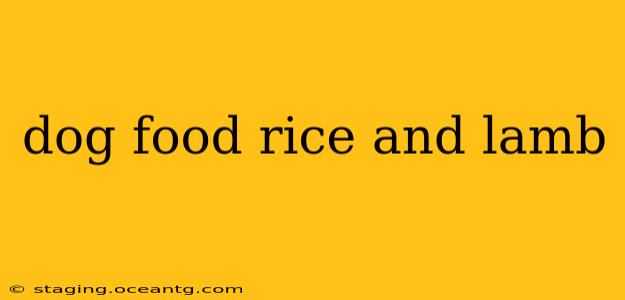Many dog owners are increasingly seeking out grain-inclusive dog food options, and rice and lamb formulas have become quite popular. But is this combination truly beneficial for your canine companion? Let's delve into the nutritional aspects, potential benefits, and things to consider when choosing a rice and lamb dog food.
What are the benefits of rice and lamb dog food?
Rice, a common grain in dog food, serves as a readily digestible carbohydrate source, providing energy. It's generally well-tolerated by dogs, even those with sensitive stomachs. Lamb, a lean protein source, is often hypoallergenic, making it a suitable choice for dogs with allergies to more common proteins like chicken or beef. The combination offers a balanced approach, providing both energy and essential amino acids for muscle building and overall health.
Is rice and lamb dog food good for sensitive stomachs?
Yes, rice and lamb is frequently recommended for dogs with sensitive stomachs or food allergies. The gentle nature of rice on the digestive system, coupled with the hypoallergenic properties of lamb, can significantly reduce digestive upset and alleviate symptoms like vomiting or diarrhea. However, it's crucial to note that not all dogs with sensitivities will tolerate lamb and rice. Individual reactions vary, and a veterinary consultation is always recommended before making dietary changes, especially for dogs with pre-existing conditions.
What are the potential downsides of rice and lamb dog food?
While generally beneficial, some potential downsides exist. Firstly, the quality of ingredients varies significantly between brands. Look for dog foods with high-quality lamb as the primary protein source and whole-grain rice, avoiding fillers and artificial additives. Secondly, some dogs may still exhibit sensitivities, even with hypoallergenic ingredients. Finally, while rice provides energy, it shouldn't be the sole carbohydrate source; a balanced diet includes other nutrients.
What are the best brands of rice and lamb dog food?
Choosing a brand depends on your dog's specific needs and your budget. It's crucial to read the ingredient list carefully, ensuring lamb is prominently listed and that the food contains minimal fillers. Look for brands that prioritize high-quality ingredients and undergo rigorous testing to maintain product consistency. Always consult with your veterinarian for recommendations based on your dog's individual needs. Avoid solely relying on online reviews, as opinions vary widely.
How much rice and lamb dog food should I feed my dog?
The appropriate amount of food depends entirely on your dog's breed, size, age, activity level, and overall health. Always follow the feeding guidelines provided on the dog food packaging. These guidelines are usually based on weight and can vary between brands. If you're unsure, consult with your veterinarian to determine the optimal feeding schedule and portion size for your dog to maintain a healthy weight and avoid obesity.
Can I make rice and lamb dog food at home?
Yes, you can prepare homemade rice and lamb dog food, but it requires careful planning to ensure nutritional balance. Consult with a veterinary nutritionist for a recipe tailored to your dog's specific dietary needs. Homemade food needs to meet all of your dog's nutritional requirements, which can be challenging to achieve without professional guidance. Inadequate nutrition can lead to serious health problems.
Is rice and lamb dog food suitable for puppies?
While rice and lamb can be a part of a puppy's diet, it's essential to choose puppy-specific formulas designed to meet their higher nutritional needs for growth and development. These formulas often contain higher levels of protein and fat compared to adult dog food. Always consult your veterinarian before making any dietary changes for your puppy.
This comprehensive guide provides a balanced perspective on rice and lamb dog food. Remember, responsible pet ownership includes making informed decisions based on your dog's unique needs and consulting with veterinary professionals when necessary.
